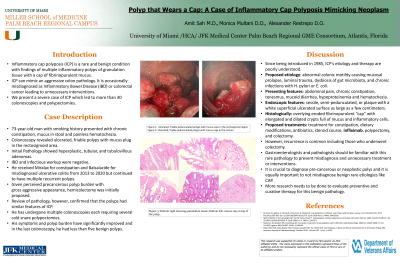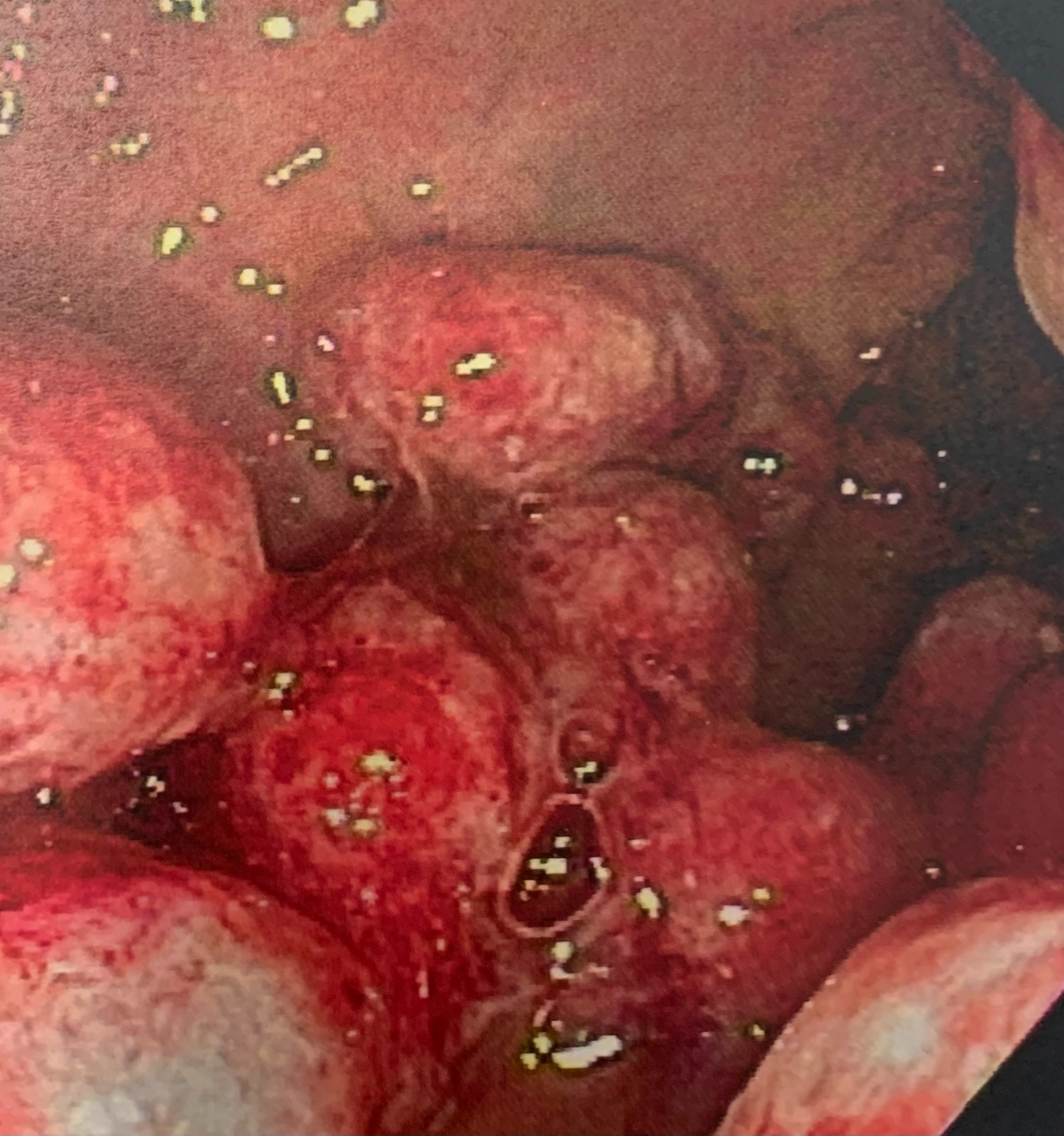Back


Poster Session D - Tuesday Morning
Category: Colon
D0142 - Polyp That Wears a Cap: A Case of Inflammatory Cap Polyposis Mimicking Neoplasm
Tuesday, October 25, 2022
10:00 AM – 12:00 PM ET
Location: Crown Ballroom

Has Audio

Amit Sah, MD
University of Miami/JFK Medical Center
Atlantis, FL
Presenting Author(s)
Amit Sah, MD1, Monica Multani, DO2, Lesley-Ann G. McCook, MD3, Alexander Restrepo, DO4
1University of Miami/JFK Medical Center, Atlantis, FL; 2Larkin Community Hospital, South Miami, FL; 3University of Miami/ JFK Medical Center Palm Beach Regional GME Consortium, Atlantis, FL; 4Veterans Affairs Medical Center, West Palm Beach, FL
Introduction: Inflammatory cap polyposis (ICP) is a rare and benign condition with findings of multiple inflammatory polyps of granulation tissue with a cap of fibrinopurulent mucus. ICP can mimic an aggressive colon pathology. It is occasionally misdiagnosed as Inflammatory Bowel Disease (IBD) or colorectal cancer leading to unnecessary interventions. We present a severe case of ICP which led to more than 30 colonoscopies and polypectomies.
Case Description/Methods: 73-year-old man with smoking history presented with chronic constipation, mucus in stool and painless hematochezia. Colonoscopy revealed ulcerated, friable polyps with mucus plug in the rectosigmoid area. Pathology showed hyperplastic, tubular, and tubulovillous adenomas. IBD and infectious workup were negative. He received Miralax for constipation and Balsalazide for UC from 2013 to 2020 but continued to have polyps. Given perceived precancerous polyp burden with gross aggressive appearance, hemicolectomy was initially proposed. Review of pathology, however, confirmed that the polyps had similar features of ICP. He has undergone multiple colonoscopies each requiring several cold snare polypectomies. His symptoms and polyp burden have significantly improved and in the last colonoscopy, he had less than five benign polyps.
Discussion: Since being introduced in 1985, ICP’s etiology and therapy are unknown. It has been linked to abnormal colonic motility causing mucosal prolapse, luminal trauma, dysbiosis of gut microbiota, and chronic infections with H. pylori or E. coli. It can be asymptomatic or present with abdominal pain, chronic constipation, tenesmus, mucoid diarrhea, hypoproteinemia and hematochezia. Endoscopically, it can appear as sessile, semi-pedunculated, or plaque with a white superficial surface as large as a few centimeters. Histologically, it has an overlying eroded fibrinopurulent “cap” with elongated and dilated crypts full of mucus and inflammatory cells. Few proposed treatments include treatment for constipation, dietary modifications, antibiotics, steroid course, polypectomy, and colectomy. However, recurrence is common including those who underwent colectomy. Gastroenterologists and pathologists should be familiar with this rare pathology to prevent misdiagnosis and unnecessary treatment or interventions. More research needs to be done to evaluate preventive and curative therapy for this benign pathology.

Disclosures:
Amit Sah, MD1, Monica Multani, DO2, Lesley-Ann G. McCook, MD3, Alexander Restrepo, DO4. D0142 - Polyp That Wears a Cap: A Case of Inflammatory Cap Polyposis Mimicking Neoplasm, ACG 2022 Annual Scientific Meeting Abstracts. Charlotte, NC: American College of Gastroenterology.
1University of Miami/JFK Medical Center, Atlantis, FL; 2Larkin Community Hospital, South Miami, FL; 3University of Miami/ JFK Medical Center Palm Beach Regional GME Consortium, Atlantis, FL; 4Veterans Affairs Medical Center, West Palm Beach, FL
Introduction: Inflammatory cap polyposis (ICP) is a rare and benign condition with findings of multiple inflammatory polyps of granulation tissue with a cap of fibrinopurulent mucus. ICP can mimic an aggressive colon pathology. It is occasionally misdiagnosed as Inflammatory Bowel Disease (IBD) or colorectal cancer leading to unnecessary interventions. We present a severe case of ICP which led to more than 30 colonoscopies and polypectomies.
Case Description/Methods: 73-year-old man with smoking history presented with chronic constipation, mucus in stool and painless hematochezia. Colonoscopy revealed ulcerated, friable polyps with mucus plug in the rectosigmoid area. Pathology showed hyperplastic, tubular, and tubulovillous adenomas. IBD and infectious workup were negative. He received Miralax for constipation and Balsalazide for UC from 2013 to 2020 but continued to have polyps. Given perceived precancerous polyp burden with gross aggressive appearance, hemicolectomy was initially proposed. Review of pathology, however, confirmed that the polyps had similar features of ICP. He has undergone multiple colonoscopies each requiring several cold snare polypectomies. His symptoms and polyp burden have significantly improved and in the last colonoscopy, he had less than five benign polyps.
Discussion: Since being introduced in 1985, ICP’s etiology and therapy are unknown. It has been linked to abnormal colonic motility causing mucosal prolapse, luminal trauma, dysbiosis of gut microbiota, and chronic infections with H. pylori or E. coli. It can be asymptomatic or present with abdominal pain, chronic constipation, tenesmus, mucoid diarrhea, hypoproteinemia and hematochezia. Endoscopically, it can appear as sessile, semi-pedunculated, or plaque with a white superficial surface as large as a few centimeters. Histologically, it has an overlying eroded fibrinopurulent “cap” with elongated and dilated crypts full of mucus and inflammatory cells. Few proposed treatments include treatment for constipation, dietary modifications, antibiotics, steroid course, polypectomy, and colectomy. However, recurrence is common including those who underwent colectomy. Gastroenterologists and pathologists should be familiar with this rare pathology to prevent misdiagnosis and unnecessary treatment or interventions. More research needs to be done to evaluate preventive and curative therapy for this benign pathology.

Figure: Ulcerated, friable pedunculated polyps with mucus caps in the rectosigmoid region.
Disclosures:
Amit Sah indicated no relevant financial relationships.
Monica Multani indicated no relevant financial relationships.
Lesley-Ann McCook indicated no relevant financial relationships.
Alexander Restrepo indicated no relevant financial relationships.
Amit Sah, MD1, Monica Multani, DO2, Lesley-Ann G. McCook, MD3, Alexander Restrepo, DO4. D0142 - Polyp That Wears a Cap: A Case of Inflammatory Cap Polyposis Mimicking Neoplasm, ACG 2022 Annual Scientific Meeting Abstracts. Charlotte, NC: American College of Gastroenterology.

